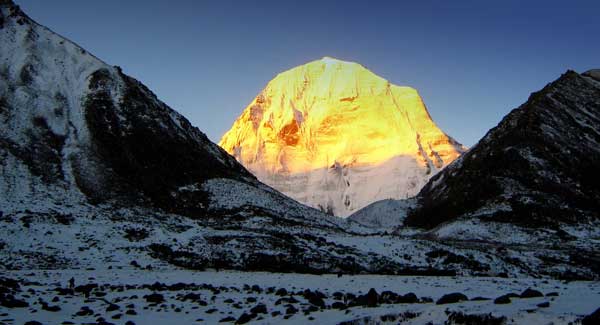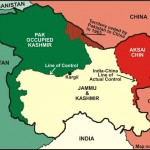IDR Blog
China playing new Border games close to Mount Kailash
 Western Tibet has a rich historical background, particularly in proximity to Mount Kailash, near the trijunction between India, Nepal and Tibet.
Western Tibet has a rich historical background, particularly in proximity to Mount Kailash, near the trijunction between India, Nepal and Tibet.
It is the case of Purang/Taklakot and a place called Toyo, located a few kilometres away, which have gone down in history for the epic battle between the Dogras of Gen. Zorawar Singh and the Tibetans troops.
In December 1841, the Dogra troops, who had just conquered Western Tibet (known as Ngari), were defeated by the Tibetans — and also by the winter.
The great Tibetan historian, Tsepon Shakabpa, thus described the battle of Taklakot/Toyo: “The Tibetan government quickly dispatched Ü Dapön [Gen.] Shedra Wangchuk Gyelpo and the Ü Tsang [Central Tibet] militia under the leadership of Cabinet minister Pellhün; when they arrived in Ngari, one regiment of the foreign army [the Dogras] was stationed at Rutok [near Pangong-tso], another was at Trashigang [near Demchok on the Ladakh border], and a third was at Rupshö [in Ladakh]. Secret preparations were made for the Tibetan troops to confront each [Dogra] unit. Zorawar Singh and the most seasoned [Dogra] troops, who were stationed at Taklakhar [Taklakot] Castle [in fact in Toyo] were confronted… In the eleventh month [December 1841], during the coldest weather of the year, the Tibetan troops attacked from all directions simultaneously.”
The fate of Zorawar Singh and his troops were sealed, according to Shakabpa:
“Three days after the fighting began, heavy snow fell. Thus, the Sikh troops who were at Taklakot became frozen solid. Trembling under their difficulties, the Sikhs were attacked by the Tibetans in terrible hand-to-hand fighting… While Zorawar Singh was riding his horse, rushing back and forth, he was recognized by a Yasor called Mikmar. He threw a spear and Zorawar Singh fell from his horse. Leaping off of his own horse, Mikmar cut Singh’s head off and carried it into the middle of the Tibetan camp. This was seen by the Sikh [Dogra] soldiers, and they fled in whatever way they could.”
A few months later, Maharaja Gulab Singh smashed the Tibetan forces trying to invade Ladakh. Dapön Zurkhang and Dapön Pelzhi were captured and taken to Leh, where a peace treaty was signed between the Dogras and the Tibetans, confirming once more the traditional border between Ladakh and Tibet. The tomb of Zorawar Singh still exists in Toyo, which has recently come in the news, but for different reasons.
An article in the Chinese media mentions a newly-built village in Toyo:
“China continues to promote the improvement of the rural living environment, paying close attention to greening [the area], beautification and [water] purification; the changes in Toyo are a concrete manifestation of the Ngari region’s efforts to build a beautiful and livable countryside.”
During the past three years, in Western Tibet alone, a total of 31 projects have been implemented to build liveable, “industrial” and beautiful villages, a local Communist Party cadre explains; in his jargon that it will be: “in accordance with the principles of beautiful leisure villages, happy and liveable villages, clean and tidy villages.”
But why a new village in Toyo?
Says Newsweek:
“China appears to have completed the construction of a new dam in the country’s southwestern border regions, a project that could have far-reaching strategic implications for its southern neighbours India and Nepal.”
Built on the Mapcha Tsangpo (or Peacock river, also known as Ghaghara or Saryu in India and Karnali in Nepal), it is a perennial source of fresh water water supply to the downstream populations.
What is strange is that the existence of this hydropower plant, located close to the Indian border, has not appeared in any published Chinese plan earlier.
Though satellite imagery only shows a medium river-of-the-river dam, without a large reservoir, India downstream should be concerned.
But there is more.
A new airport is coming up a couple of kilometres north of the hydropower plant and the “model” village. In June 2018, the Civil Aviation Administration of China had announced that Tibet would soon have three new airports. The Chinese-language press had given some information about the location of these three airports: one was to be located in Lhuntse, north of Arunachal Pradesh, the second was north of a border post with Nepal and the last in Purang.
Chinese website seetao.com explained:
“These three airports can be used for civilian use in peacetime, military aircraft training on the plateau; direct military use in wartime, holding military operations, will be able to play a very important role.”
Though many in India had forgotten about this announcement, the airport is now functional; on November 10, 2023, videos of the newly-built airfield appeared on the Chinese social media.
These three developments (model village, hydropower station and airport) should be seen as one, undoubtedly all are for dual (civil and military) use.
A separate occurrence needs to be noticed: the closure of the Kailash Yatra to Indian pilgrims. The 6,638-metre-tall diamond-shaped mountain is considered to be the abode of Lord Shiva and also one of the most sacred places in the Jain, Buddhist and Bon religions.
For centuries, pilgrims from India have visited the holy site; since the 1990s, they could cross into Tibet via Lipulekh Pass in Pittoragarh district and later enter Tibet via Nathu-la in Sikkim.
After the Doklam incident in 2017, the Indian yatris were not allowed to use these routes anymore.
As Beijing ignored Kathmandu’s request to permit the aerial sightseeing of Mount Kailash, Nepali tour operators decided to offer the yatris an alternative and a large number of devotees started using the Nepal route from Simikot to Purang by chartered helicopters; unfortunately, the scheme was subsequently closed due to the Covid-19 pandemic.
After the scheme reopened for Nepalis in 2022, the Chinese authorities did not allow Indian visitors to fly to Purang, though last year alone, Nepali tour operators received over 50,000 bookings from Indian pilgrims for the sacred pilgrimage.
According to the Kathmandu Post, a new alternative has been found: a flight could remain in Nepalese territory and have a “remote” darshan of the sacred mountain: “Shree Airlines operated a first-of-its-kind aerial pilgrimage tour of the holy places, making the pilgrims’ dream come true without a Chinese visa” — explained a communiqué last week.
It is clear that China does not want Indians to have a real darshan of the holy mountain, or even come close to the place where Zorawar Singh is buried; and these latest developments in the area explain why.
Courtesy: https://claudearpi.blogspot.com/2024/02/claude-arpi-china-playing-new-border.html?m=1
Post your Comment
2 thoughts on “China playing new Border games close to Mount Kailash”
 Loading Comments
Loading Comments




China will be neutralised by the Divine Power of Bholenath. Sooner or later this mount kailas will be with the Sanatanis
I think we need to go back to medieval times and start a war with china and make Tibet Indian territory!!!